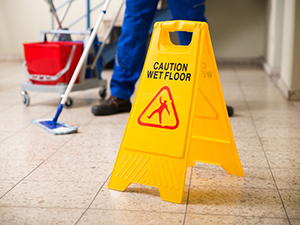
By Denis Boulais, national risk manager, Broadlex Services
Slips, trips and falls can result in some horrific injuries, hence it is vital that an organisation develops procedures that address control measures in relation to hazard identification, assessment and control.
Procedures may include a number of measures based upon risk assessment such as matting and slippery when wet signage placement on rainy days.
In addition to procedures having a strong preventative focus there must be an equally proactive post incident focus particularly where members of the public may become involved.
Public liability claims in my experience creep out of the woodwork years after the event and really all one has to rely upon is the detail associated with the investigation at the time of the incident. As such, a full detailed investigation is very important and where possible with photographs, witness statements and any relevant rotation tracking or CCTV data.
Consultation and communication is critical within the risk management process. There must be extensive consultation with workers exposed to slips, trips and fall hazards to ensure their work processes are fully risk assessed. With slips, trips and falls additional consultation may be considered in liaison with the client as joint cooperation can have significant dividends.
Training
Training is also vital and where possible should be generic, site specific and competency based. When designing training programs it is important to remember that one remembers 10 per cent of what they hear, 51 per cent of what they see and hear and finally 92 per cent of what they see and hear and become involved in. Such training may emphasise the placement of slippery when wet signage as required and leaving it out until the floor is completely dry.
Other important areas may include:
- Fast, detailed and accurate incident reporting
- Hazard reporting (for example poor lighting)
- Effective housekeeping and wearing appropriate footwear
- Not carrying anything that blocks vision (particularly on stairs)
Risk control
Risk identification, assessment and control are the heart of the risk management process. Many people don’t report falls as they feel stupid. Have you ever seen someone fall over in the street, quickly get up and then glance around to see who may have seen the fall? When a fall is not reported then the risk assessment process is hindered as is the potential for any information gathering that may be crucial in potential future management of the matter.
Risk control may involve a variety of approaches all of which must be derived via detailed risk assessment. Such risk control strategies may include:
- Giving consideration to altering the surface of the floor
- Choosing appropriate footwear in relation to the work environment
- Applying non slip surface treatments
- Having plenty of slippery when wet signage available
- Ensuring matting is appropriate and not a trip hazard in itself
- Never removing slippery when wet floor signage until the floor is completely dry
- Consulting and liaising with the client where any risks are identified or foreseen
To continue reading this article, view the digital version of INCLEAN magazine. To subscribe to INCLEAN magazine click here.